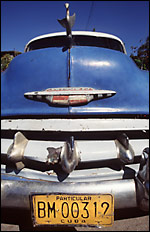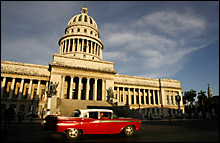Backstory: Hitchhiking my way around Cuba
 TIME WARP:
Most of the cars on the island predate the '70s, like this 1950
Chevrolet found in Santa Fe. A state restriction prohibits average
citizens from buying cars not already in the country.
TIME WARP:
Most of the cars on the island predate the '70s, like this 1950
Chevrolet found in Santa Fe. A state restriction prohibits average
citizens from buying cars not already in the country.
MELANIE STETSON FREEMAN/CSM/FILE
From a vintage Chevy to a buggy ride, adventure proves a
corner – and a thumb – away.
By
Danna Harman
| Correspondent of The
Christian Science Monitor
TRINIDAD, CUBA – In
perhaps a moment of lapsed judgment, I recently decided to travel around
Cuba the way most Cubans do - by thumb. And so, on a cloying Caribbean
day, I found myself standing under palm trees on a road outside Trinidad
with an off-duty policeman and his family. We were waiting for passing
cars to stop. We were hitchhiking.
These days, wherever you travel,
someone - usually your mother - will warn you that hitchhiking is not
advisable. But in Cuba it's a way of life. "Here, your car is your
brother's car," Araceli, a grandmother in Trinidad, explained to me.
"That's the essence of Cuba."
But, the spirit of socialism aside,
picking up hitchhikers is also required in Cuba. And, as far as I
could tell, it would be hard for anyone to get anywhere if it weren't.
The first thing you need to know about Cuban
transportation is there isn't much of it. According to a 1997 World Bank
study, only 32 cars exist for every 1,000 people - about the same ratio
as in 1958, a year before the revolution. The US, by comparison, has 808
per 1,000.
To buy a new car, you need state permission. This is
granted exclusively to senior state workers, certain medical
professionals, and VIPs. Regular Cubans are restricted to owning
vehicles already in the country, mostly American classics from the
pre-1970s - cars with big grilles, big fins, and big gas bills. Few
spare parts exist because of the US embargo.
Public transportation is scarce and overcrowded. People
line up for hours to get on buses or "camels," 18-wheelers transformed
into lumbering transport vehicles. Taxis belong to the state and are too
expensive for all but tourists. While some private car owners can get
permission to run taxi collectives, these are as unreliable as the
vintage cars themselves. There is always biking and walking. But, I was
told, hitchiking was a top bet.
Outside Trinidad, it became clear that life on the road
involved a lot of waiting by the side of it. An hour after arriving, I
was still standing there with the off-duty policeman and co. By then, we
had been joined by a family going to the beach, a dozen people heading
to work, an elderly man on crutches, a young couple on a date, and a
church group. And, of course, an "amarillo."
As might be expected, hitchhiking in a land of rules is
no free-wheeling affair. State officials, known as amarillos for their
yellow uniforms, are stationed along the country's highways to oversee
the process. Their job - for which they earn a respectable 400 pesos
($15) a month - is to make lists of riders and flag down passing cars.
Not all cars are required to stop. Those with yellow,
caramel, and white plates indicate state vehicles and must pull over.
Brown plates (military) and blue (private) should stop but don't have
to. Little is expected of green (tourists) or black (diplomats) plates
because, as Araceli explained, "they think differently about their
responsibilities to the community."
The system is not without problems. Theoretically,
drivers in state cars who don't stop can be fined. But a suspiciously
high number passed by, making a "turning in a moment" sign with their
hand. Others just ignored their community responsibility altogether -
leaving the amarillos vainly trying to scribble down plate numbers.
Finally, I decided to give up and take a collective taxi
going to Sancti Spiritus. The price, announced the driver's assistant,
was 5 pesos (18 cents), to be collected by assistant No. 2. Half the
people at the hitchhiking stop paid up and piled into the '56 Chevrolet.
"Not to worry," the policeman assured me as I waved goodbye. His free
ride would eventually come. "The system is slow," he said. "But it
works."
Fernando, the Chevy's driver, was really a rowing
instructor who earned a state salary of 500 pesos ($19) a month. But he
inherited a '54 Buick several years ago, which he fixed up and traded
for the Chevy. He filled out the paperwork and, a year later, got
approval to switch jobs and become a driver - and now makes four times
what he did as an instructor.
Such permission, of course, comes with regulations. He
can, for example, only make one run on his two-hour route a day. "Why?"
I ask. "That's just the rule," he said, bemused at the question and
slowing down for the second police inspection in half an hour.
On Day 2, I didn't hitchhike either. I wanted to. But it
was not to be. I was told the Sancti Spíritus-Caibarién road, where I
was going, was a bus route, which meant no amarillos, few hitchers, and
even fewer people moved by the spirit of socialism. There was only one
other problem - the bus was only for Cubans. I could have taken the
tourist bus - at nine times the price - but it had just left, according
to station master Fidelito. But not to worry: Fidelito's friend, Juan,
who runs a small unofficial transport business, was going to help.
Soon enough, Juan and I were road-tripping along in his
rebuilt Russian Lada. He would be fined if caught with a foreigner, so
he asked me to pretend I was a mute cousin. Later, we made a detour to
see a monument to Camilo Cienfuegos, a hero of the revolution, in
Yaguajay. It was impressive, but we had to whiz by to avoid police. I
stared out the window at coconut trees and billboards. "Life is worth
living," read one. "Plant ideas and they will grow," suggested another.
I was getting discouraged with hitchhiking, when, on Day
3, it all came together. As I stood outside Remedios, an amarillo
finally stopped a state vehicle, a minivan filled with workers returning
from a "fun day" at the beach. I jumped in. We then pulled over for the
driver to buy some avocados. We stopped later for onions for the
driver's assistant. We picked up a family going to see cousins. No one
talked to me, but it felt great. I was hitchhiking.
I got dropped off in Santa Clara, where I went to the Che
Guevara museum. And then, still humming the catchy revolutionary tunes
piped in over the speakers there, I got another ride. And another - all
the way back to Havana. My fortunes had turned.
There was Pablo with his horse and buggy, who wedged my
laptop bag between his legs and the horse's backside for "safekeeping."
Caesar and Diego from the national water department, who told me about
their time as soldiers in Angola. And Luis Alfonso, a cancer specialist,
who took me for tea at his great aunt's home. By the time I rolled into
Havana the next evening, chatting baseball with my new friend Jamie from
the Finance Ministry, I was a bona fide hitchhiker - living the Cuban
experience.
I was also ready to hail a tourist cab.
|
